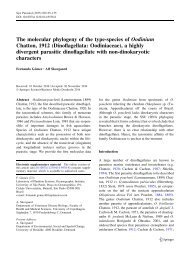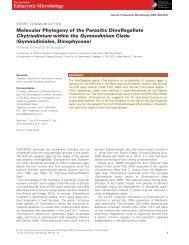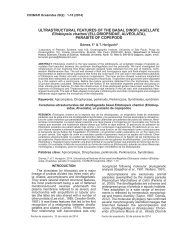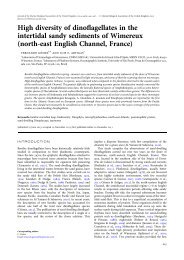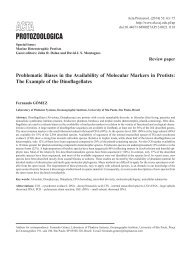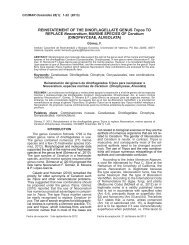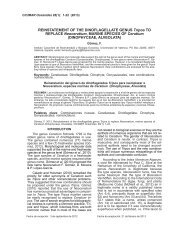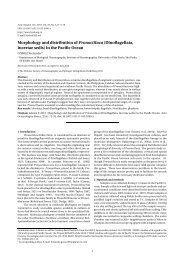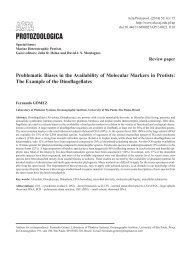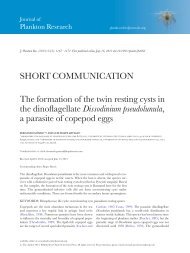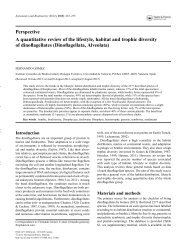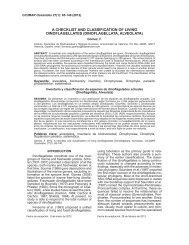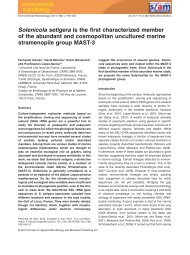Sinophysis and Pseudophalacroma are Distantly Related to Typical Dinophysoid Dinoflagellates (Dinophysales, Dinophyceae)
Dinophysoid dinoflagellates are usually considered a large monophyletic group. Large subunit and small subunit (SSU) rDNA phylogenies suggest a basal position for Amphisoleniaceae (Amphisolenia, Triposolenia) with respect to two sister groups, one containing most Phalacroma species plus Oxyphysis and the other Dinophysis, Ornithocercus, Histioneis, Citharistes and some Phalacroma species. We provide here new SSU rDNA sequences of Pseudophalacroma (pelagic) and Sinophysis (the only benthic dinophysoid genus). Molecular phylogenies support that they are very divergent with respect to the main clade of Dinophysales. Additional molecular markers of these two key genera are needed to elucidate the evolutionary relations among the dinophysoid dinoflagellates.
Dinophysoid dinoflagellates are usually considered a large monophyletic group. Large subunit and small subunit
(SSU) rDNA phylogenies suggest a basal position for Amphisoleniaceae (Amphisolenia, Triposolenia) with respect to two sister
groups, one containing most Phalacroma species plus Oxyphysis and the other Dinophysis, Ornithocercus, Histioneis, Citharistes
and some Phalacroma species. We provide here new SSU rDNA sequences of Pseudophalacroma (pelagic) and Sinophysis (the only
benthic dinophysoid genus). Molecular phylogenies support that they are very divergent with respect to the main clade of Dinophysales.
Additional molecular markers of these two key genera are needed to elucidate the evolutionary relations among the dinophysoid
dinoflagellates.
Create successful ePaper yourself
Turn your PDF publications into a flip-book with our unique Google optimized e-Paper software.
The Journal of<br />
Eukaryotic Microbiology<br />
Published by<br />
the International<br />
Society of<br />
Protis<strong>to</strong>logists<br />
J. Eukaryot. Microbiol., 59(2), 2012 pp. 188–190<br />
© 2011 The Author(s)<br />
Journal of Eukaryotic Microbiology © 2011 International Society of Protis<strong>to</strong>logists<br />
DOI: 10.1111/j.1550-7408.2011.00598.x<br />
<strong>Sinophysis</strong> <strong>and</strong> <strong>Pseudophalacroma</strong> <strong>are</strong> <strong>Distantly</strong> <strong>Related</strong> <strong>to</strong> <strong>Typical</strong> <strong>Dinophysoid</strong><br />
<strong>Dinoflagellates</strong> (<strong>Dinophysales</strong>, <strong>Dinophyceae</strong>)<br />
FERNANDO GO´ MEZ, a DAVID MOREIRA b <strong>and</strong> PURIFICACIO´ NLO´ PEZ-GARCI´ A b<br />
a Institu<strong>to</strong> Cavanilles de Biodiversidad y Biologı´a Evolutiva, Universidad de Valencia, Valencia, Spain, <strong>and</strong><br />
b Unite´ d’Ecologie, Syste´matique et Evolution, CNRS UMR 8079, Universite´ Paris-Sud, Baˆtiment 360, 91405, Orsay Cedex, France<br />
ABSTRACT. <strong>Dinophysoid</strong> dinoflagellates <strong>are</strong> usually considered a large monophyletic group. Large subunit <strong>and</strong> small subunit<br />
(SSU) rDNA phylogenies suggest a basal position for Amphisoleniaceae (Amphisolenia, Triposolenia) with respect <strong>to</strong> two sister<br />
groups, one containing most Phalacroma species plus Oxyphysis <strong>and</strong> the other Dinophysis, Ornithocercus, Histioneis, Citharistes<br />
<strong>and</strong> some Phalacroma species. We provide here new SSU rDNA sequences of <strong>Pseudophalacroma</strong> (pelagic) <strong>and</strong> <strong>Sinophysis</strong> (the only<br />
benthic dinophysoid genus). Molecular phylogenies support that they <strong>are</strong> very divergent with respect <strong>to</strong> the main clade of <strong>Dinophysales</strong>.<br />
Additional molecular markers of these two key genera <strong>are</strong> needed <strong>to</strong> elucidate the evolutionary relations among the dinophysoid<br />
dinoflagellates.<br />
Key Words. Dinoflagellata, Dinophysis, Gymnodiniales–Peridiniales–Prorocentrales lineage, s<strong>and</strong> dwelling protist, SSU rDNA<br />
phylogeny.<br />
EXTANT dinoflagellates show five basic types of tabulation:<br />
peridinioid, gonyaulacoid, dinophysoid, prorocent-<br />
from its type locality, the open Mediterranean Sea, <strong>and</strong> a sec-<br />
<strong>Pseudophalacroma</strong>, <strong>Pseudophalacroma</strong> nasutum (F. Stein) Jørg.,<br />
roid <strong>and</strong> gymnodinioid, which <strong>are</strong> the basis for a ond undescribed <strong>Pseudophalacroma</strong> species. Phylogenetic analyses<br />
dinoflagellate classification in<strong>to</strong> five major orders (Taylor<br />
1980). The dinophysoid dinoflagellates <strong>are</strong> considered a monophyletic<br />
suggest that these species <strong>are</strong> very divergent with respect<br />
<strong>to</strong> the other dinophysoids.<br />
group in both classical taxonomical schemes <strong>and</strong><br />
molecular phylogenetic analyses from available data (H<strong>and</strong>y<br />
et al. 2009; Hastrup, Jensen, <strong>and</strong> Daugbjerg 2009). The dinophysoids<br />
have a remarkable variety of forms, ranging from<br />
less ornamented species with a Phalacroma-like outline, usually<br />
regarded as the ancestral forms, <strong>to</strong> highly ornamented<br />
species from warm oceans that harbour diazotrophic symbionts<br />
(Ornithocercus F. Stein, Histioneis F. Stein). Despite major<br />
differences in general appearance, the arrangement <strong>and</strong> number<br />
of their thecal plates <strong>are</strong> highly conserved among the<br />
investigated dinophysoid genera (Abé 1967; Balech 1980).<br />
Authors who attempted <strong>to</strong> elucidate the dinophysoid radiation<br />
proposed that the ancestral dinophysoid would be a small cell<br />
resembling the Phalacroma F. Stein outline, with horizontal<br />
cingular lists <strong>and</strong> simplified morphology with a narrow sulcal<br />
list without ribs (Hallegraeff <strong>and</strong> Lucas 1988; Kofoid <strong>and</strong><br />
Skogsberg 1928). In addition, Abe´ (1967) <strong>and</strong> Taylor (1980)<br />
proposed as an alternative hypothesis an ances<strong>to</strong>r resembling<br />
the microcephalic <strong>Sinophysis</strong> D.S. Nie et Chia C. Wang.<br />
Taylor (1980) also suggested a similarity of <strong>Sinophysis</strong> with<br />
the fossil Nannocera<strong>to</strong>psis Defl<strong>and</strong>re, considered a missing link<br />
between dinophysoids <strong>and</strong> peridinioids.<br />
The oceanic genus <strong>Pseudophalacroma</strong> Jørg. shows little morphological<br />
specialization. It possesses an atypical notch in the<br />
epitheca with two highly elongated ventral epithecal plates.<br />
The microcephalic <strong>Sinophysis</strong> is the only known benthic dinophysoid<br />
<strong>and</strong> superficially resembles a Prorocentrum Ehrenb.<br />
cell with a small epitheca (Abé 1967). <strong>Pseudophalacroma</strong> <strong>and</strong><br />
<strong>Sinophysis</strong> <strong>are</strong> characterized by a reduced sulcal list with<br />
highly reduced or absent supporting ribs. They could be considered<br />
representative forms of the primitive Phalacroma <strong>and</strong><br />
the microcephalic hypothetical dinophysoid ances<strong>to</strong>rs, respectively<br />
(Abe´ 1967; Taylor 1980).<br />
MATERIALS AND METHODS<br />
The specimens of P. nasutum were collected in open Mediterranean<br />
waters (see Fig. S1 <strong>and</strong> Table S1 as Supporting Information).<br />
Ten litres of seawater were collected from the surface<br />
with a bucket <strong>and</strong> filtered using a strainer of 20-lm netting<br />
aperture. The retained material was fixed with 50% ethanol<br />
(final concentration) <strong>and</strong> examined in Utermo¨ hl chambers<br />
with an Olympus (Tokyo, Japan) IX51 inverted microscope<br />
with an Olympus DP71 camera. A second <strong>Pseudophalacroma</strong><br />
species was isolated from a sample collected in the Marmara<br />
Sea (Table S1). A volume of 36 liters was filtered with a<br />
20-lm nylon collec<strong>to</strong>r <strong>and</strong> cells resuspended in 0.22-lmfiltered<br />
seawater <strong>and</strong> fixed in ethanol (~80% final concentration).<br />
The concentrated sample was examined in Utermo¨ hl<br />
chambers with a Nikon (Tokyo, Japan) Eclipse TE2000-S<br />
inverted microscope with a Nikon DS-2M camera. <strong>Sinophysis</strong><br />
specimens were isolated from s<strong>and</strong> samples in a tidal pool on<br />
Wimereux beach, English Channel (Fig. S1 <strong>and</strong> Table S1).<br />
The upper centimetre of s<strong>and</strong> was collected with a spoon,<br />
deposited in a bottle, rinsed with seawater <strong>and</strong> stirred vigorously.<br />
The resulting suspension was settled in a composite<br />
Utermo¨ hl chamber <strong>and</strong> examined with a Nikon (Tokyo)<br />
Eclipse TE2000-S inverted microscope with a Nikon DS-2M<br />
camera.<br />
Each specimen was micropipetted individually with a fine<br />
capillary in<strong>to</strong> a clean chamber, washed several times in serial<br />
drops of 0.2-lm sterilized water <strong>and</strong> finally deposited in<strong>to</strong> a<br />
0.2-ml Eppendorf tube with several drops of absolute ethanol.<br />
SSU rDNAs were amplified from each single cell following<br />
three rounds of nested PCR with the primers EK-42F (5′-CT<br />
CAARGAYTAAGCCATGCA-3′) <strong>and</strong> EK-1520R (5′-CYGC<br />
We determined sequences of small subunit (SSU) rRNA AGGTTCACCTAC-3′); EK-82F (5′-GAAACTGCGAAT<br />
sequences for two <strong>Sinophysis</strong> species, <strong>Sinophysis</strong> ebriola GGCTC-3′) <strong>and</strong> EK-1498R (5′-CACCTACGGAAACC<br />
(Herdman) Balech <strong>and</strong> <strong>Sinophysis</strong> gr<strong>and</strong>is Hoppenrath, collected<br />
near their type localities, the British coasts <strong>and</strong> the<br />
North Sea, respectively, <strong>and</strong> five sequences of the type of<br />
TTGTTA-3′); <strong>and</strong> DIN464F (5′-TAACAATACAGGGCATC<br />
CAT-3′) <strong>and</strong> EK-1498R. PCR amplification of SSU rRNA<br />
genes <strong>and</strong> sequencing were done as described in Go´ mez,<br />
Lo´ pez-Garcı´ a, <strong>and</strong> Moreira (2011). Sequences were aligned<br />
Corresponding Author: F. Go´ mez, Institu<strong>to</strong> Cavanilles de Biodiversidad<br />
y Biologı´ a Evolutiva, PO Box 22085, 46071 Valencia, Spain genetic analyses were carried out with TREEFINDER (Jobb,<br />
using MUSCLE 3.7 (Edgar 2004). Maximum likelihood phylo-<br />
—Telephone number: +34 963543209; FAX number: +34 von Haeseler, <strong>and</strong> Strimmer 2004) applying a GTR + Γ + I<br />
963543670; e-mail: fern<strong>and</strong>o.gomez@fi<strong>to</strong>planc<strong>to</strong>n.com<br />
model of nucleotide substitution <strong>and</strong> 1,000 bootstrap replicates.<br />
188
GO´ MEZ ET AL.—MOLECULAR PHYLOGENY OF DINOPHYSOID DINOFLAGELLATES 189<br />
Fig. 1. Maximum likelihood phylogenetic tree of dinoflagellate SSU rDNA sequences, based on 1,214 aligned positions. Names in bold represent<br />
sequences obtained in this study. Numbers at the nodes <strong>are</strong> bootstrap proportions (values under 50% <strong>are</strong> omitted). Accession numbers<br />
<strong>are</strong> provided between brackets. The scale bar represents the number of substitutions for a unit branch length.
190 J. EUKARYOT. MICROBIOL., 59, NO. 2, MARCH–APRIL 2012<br />
Alignments can be obtained by request <strong>to</strong> the corresponding<br />
author.<br />
RESULTS AND DISCUSSION<br />
Phylogenetic analysis of SSU rDNAs showed a main<br />
dinophysoid clade composed by the genera Amphisolenia<br />
F. Stein, Dinophysis Ehrenb., Histioneis, Ornithocercus, Triposolenia<br />
F. Stein, Phalacroma (including Oxyphysis oxy<strong>to</strong>xoides<br />
Kof.) with high bootstrap proportion (BP of 97%). As in previous<br />
analyses (Go´ mez et al. 2011), this clade of <strong>Dinophysales</strong><br />
sensu stric<strong>to</strong> did not show any strongly supported close affiliation<br />
<strong>to</strong> any other dinoflagellate group, making it difficult <strong>to</strong><br />
infer its relative position with respect <strong>to</strong> the other dinoflagellate<br />
orders (Fig. 1). However, the new <strong>Sinophysis</strong> spp. <strong>and</strong><br />
<strong>Pseudophalacroma</strong> spp. sequences appe<strong>are</strong>d in separate clades<br />
<strong>and</strong> also separated from the <strong>Dinophysales</strong> s.s. Although based<br />
on a single molecular marker, this result suggests that all<br />
dinoflagellates with dinophysoid morphology might not form<br />
a monophyletic group. Four of the five P. nasutum sequences<br />
were <strong>to</strong>tally identical (Fig. S2). This species formed a highly<br />
supported clade (BP 98%) with <strong>Pseudophalacroma</strong> sp. The<br />
two <strong>Sinophysis</strong> species sequences (which were quite distantly<br />
related with only 94% identity) branched within a weakly<br />
supported group (BP 69%) containing the benthic genera of<br />
atypical tabulation Amphidiniella T. Horig. <strong>and</strong> Pileidinium<br />
M. Tamura et T. Horig., the type of Peridinium Ehrenb., as<br />
well as various benthic species of Prorocentrum with a symmetrical<br />
valve (i.e. P. lima [Ehrenb.] J.D. Dodge). Depending<br />
on the taxonomic sampling used, our two species of <strong>Pseudophalacroma</strong><br />
branched sometimes with a very low support<br />
within this clade (data not shown) or as an independent lineage<br />
among the Gymnodiniales–Peridiniales–Prorocentrales<br />
lineage (Fig. 1). The large evolutionary distance between the<br />
three separate dinophysoid lineages was also observed in an<br />
unrooted SSU rDNA tree with only dinophysoid species (Fig.<br />
S2). A similar analysis considering the full alignment length<br />
(1,646 positions) recovered a similar tree, where <strong>Sinophysis</strong><br />
<strong>and</strong> <strong>Pseudophalacroma</strong> <strong>are</strong> also separated from the main dinophysoid<br />
clade (Fig. S3).<br />
We further tested the possible monophyly of all dinophysoids<br />
using Approximately Unbiased (AU) tests <strong>to</strong> comp<strong>are</strong><br />
the <strong>to</strong>pology shown in Fig. 1 with alternative trees in which<br />
we constrained (i) the monophyly of the main dinophysoid<br />
clade plus <strong>Sinophysis</strong>, (ii) the main dinophysoid clade plus<br />
<strong>Pseudophalacroma</strong> or (iii) the main dinophysoid clade plus<br />
<strong>Sinophysis</strong> <strong>and</strong> <strong>Pseudophalacroma</strong> (in each case, only the indicated<br />
node was constrained <strong>and</strong> the rest of the tree <strong>to</strong>pology<br />
was optimized). The AU tests rejected the two last possibilities<br />
(with P = 0.045 <strong>and</strong> P = 0.036, respectively) but not the first<br />
one (P = 0.23). Therefore, we could not discard that <strong>Sinophysis</strong><br />
spp. might be sister group of the main dinophysoid clade,<br />
but the separation of <strong>Pseudophalacroma</strong> spp. from this clade<br />
appe<strong>are</strong>d <strong>to</strong> be significantly rejected, though it has <strong>to</strong> be confirmed<br />
by the analysis of additional molecular markers.<br />
Our SSU rDNA phylogeny is compatible with the hypothesis<br />
that dinophysoids, at least <strong>Sinophysis</strong>, derives from a peridinioid-like<br />
ances<strong>to</strong>r that would have reduced the number of<br />
plates after the fusion of some of its thecal plates. The evolution<br />
of the dinophysoids appears <strong>to</strong> be more complex than<br />
previously considered. The <strong>Sinophysis</strong> lineage appears <strong>to</strong> be<br />
potentially very interesting <strong>to</strong> address the possible evolutionary<br />
origin of the dinophysoids <strong>and</strong> might serve <strong>to</strong> tentatively<br />
explain the relationships with prorocentroids <strong>and</strong> the hypothetical<br />
peridinioid ances<strong>to</strong>r. More molecular markers of the<br />
key genera <strong>Sinophysis</strong> <strong>and</strong> <strong>Pseudophalacroma</strong> <strong>are</strong> needed <strong>to</strong><br />
elucidate the evolutionary relations among the dinophysoid<br />
dinoflagellates.<br />
ACKNOWLEDGMENTS<br />
F.G. is supported by the contract JCI-2010-08492 of the<br />
Ministerio Espan˜ ol de Ciencia y Tecnología. We acknowledge<br />
financial support from the French CNRS <strong>and</strong> the ANR Biodiversity<br />
program (ANR BDIV 07 004-02 “Aquaparadox”).<br />
LITERATURE CITED<br />
Abe´ , T. H. 1967. The armored Dinoflagellata: II. Prorocentridae <strong>and</strong><br />
Dinophysidae (A). Publ. Se<strong>to</strong> Mar. Biol. Lab., 14:369–389.<br />
Balech, E. 1980. On the thecal morphology of dinoflagellates with<br />
special emphasis on cingular <strong>and</strong> sulcal plates. Anales Cent. Cienc.<br />
Mar Limnol. Univ. Nac. Aut. Me´xico, 7:57–68.<br />
Edgar, R. C. 2004. MUSCLE: multiple sequence alignment with high<br />
accuracy <strong>and</strong> high throughput. Nucleic Acids Res., 32:1792–1797.<br />
Go´ mez, F., Lo´ pez-Garcı´ a, P. & Moreira, D. 2011. Molecular phylogeny<br />
of dinophysoid dinoflagellates: the systematic position of Oxyphysis<br />
oxy<strong>to</strong>xoides <strong>and</strong> the Dinophysis hastata group (<strong>Dinophysales</strong>,<br />
<strong>Dinophyceae</strong>). J. Phycol., 47:393–406.<br />
Hallegraeff, G. M. & Lucas, I. A. N. 1988. The marine dinoflagellate<br />
genus Dinophysis (<strong>Dinophyceae</strong>): pho<strong>to</strong>synthetic, neritic <strong>and</strong> nonpho<strong>to</strong>synthetic,<br />
oceanic species. Phycologia, 27:25–42.<br />
H<strong>and</strong>y, S. M., Bachvaroff, T. R., Timme, R. E., Coats, D. W., Kim, S.<br />
& Delwiche, C. F. 2009. Phylogeny of four Dinophysiacean genera<br />
(<strong>Dinophyceae</strong>, Dinophysiales) based on rDNA sequences from<br />
single cells <strong>and</strong> environmental samples. J. Phycol., 45:1163–1174.<br />
Hastrup Jensen, M. & Daugbjerg, N. 2009. Molecular phylogeny of<br />
selected species of the order Dinophysiales (<strong>Dinophyceae</strong>) - testing<br />
the hypothesis of a dinophysioid radiation. J. Phycol., 45:1136–<br />
1152.<br />
Jobb, G., von Haeseler, A. & Strimmer, K. 2004. TREEFINDER: a<br />
powerful graphical analysis environment for molecular phylogenetics.<br />
BMC Evol. Biol., 4:18.<br />
Kofoid, C. A. & Skogsberg, T. 1928. The <strong>Dinophysoid</strong>eae. Mem.<br />
Mus. Comp. Zool. Harv., 51:1–766.<br />
Taylor, F. J. R. 1980. On dinoflagellate evolution. BioSystems, 13:65–<br />
108.<br />
SUPPORTING INFORMATION<br />
Additional Supporting Information may be found in the<br />
online version of this article:<br />
Table S1. List of new SSU rDNA sequences of <strong>Pseudophalacroma</strong><br />
spp. <strong>and</strong> <strong>Sinophysis</strong> spp. used for the phylogenetic<br />
analysis.<br />
Fig. S1. Micrographs of the specimens of <strong>Pseudophalacroma</strong><br />
spp. <strong>and</strong> <strong>Sinophysis</strong> spp. used for single-cell PCR analysis (see<br />
Table S1 for details).<br />
Fig. S2. Maximum likelihood phylogenetic tree of dinophysoid<br />
SSU rDNA sequences, based on 1,238 aligned positions.<br />
Fig. S3. Maximum likelihood phylogenetic tree of dinophysoid<br />
SSU rDNA sequences, based on 1,646 aligned positions.<br />
Please note: Wiley-Blackwell <strong>are</strong> not responsible for the<br />
content or functionality of any supporting materials supplied<br />
by the authors. Any queries (other than missing material)<br />
should be directed <strong>to</strong> the corresponding author for the article.<br />
Received: 06/24/11; accepted: 10/18/11



